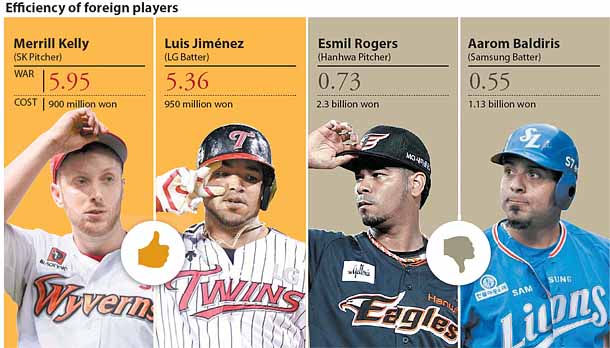Cost of signing foreign players has been getting higher

Last year, the average cost of one foreign player was 800 million won ($660,000). After increasing this year to $850,000, the average annual salary soared to $955,000. For 2017, seven foreign players’ cleared $1 million, including Hector Noesi (KIA, $1.7 million) and Wilin Arismendy Rosario (Hanwha, $1.5 million).
Eleven free agents remain, including Dustin Nippert, who cleared $1.2 million this year, and next year’s foreign player annual salaries are projected to exceed $1 million.
Signing costs are climbing due to foreign players accounting for a larger part of teams’ strength. This year, of the 42 foreign players who, at some point, played for the 10 teams, their Wins Above Replacement (WAR) total was 84.71 and amounted to 23 percent of the overall figure. In the Korea Baseball Organization (KBO), there are currently 27 foreign players total.

Considering the contribution of foreign players, based on their WARs, perhaps the cost-benefit of foreign players’ signing cost of 33 percent is unwarranted. WAR is an index used in Sabermetrics, the statistical analysis of baseball, used to evaluate a players’ overall value. WAR 1 means, compared to a replacement player, the player in question would produce one more win.
Nevertheless, the investing costs for foreign players continue to increase as time passes. The highest WAR total, 14.31, belongs to Doosan’s three foreigners — Nippert, Michael Bowden and Nick Evans. Doosan won the Korean Series championship and the regular season.
On the other hand, Hanwha’s foreign players’ active weight was not more than 12 percent. Esmil Rogers was out due to an elbow injury in the early season and Alex Maestri was in a slump. Hanwha’s two foreign replacements, Eric Surkamp and Fabio Castillo, proved insignificant in terms of activity.
The Samsung Lion’s Allen Webster and Aaron Baldiris also left the Future’s League due to injuries and slumps. The Samsung foreign players’ were analyzed as constituting a WAR of -0.10. The cost for foreign players adding WAR 1 is calculated to average 400 million won. Compared to last year, when it cost 300 million won, the efficiency of investment has fallen.
Lee Young-hoon, professor of economics at Sogang University, explained, “The top three this year are Doosan, NC and Nexen, who did well in finding undervalued players.”
They sought to moneyball, or buy undervalued players and sell overvalued ones. For three years, NC and Nexen’s investment efficiency was the best — WAR 1 to 150 million won. The two teams have proficient scouts specializing in sabermetrics for foreign players.
BY KIM WON [enational@joongang.co.kr]










with the Korea JoongAng Daily
To write comments, please log in to one of the accounts.
Standards Board Policy (0/250자)